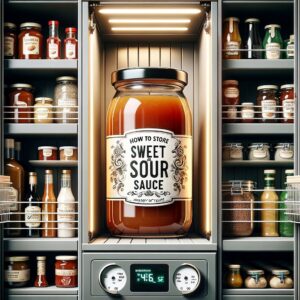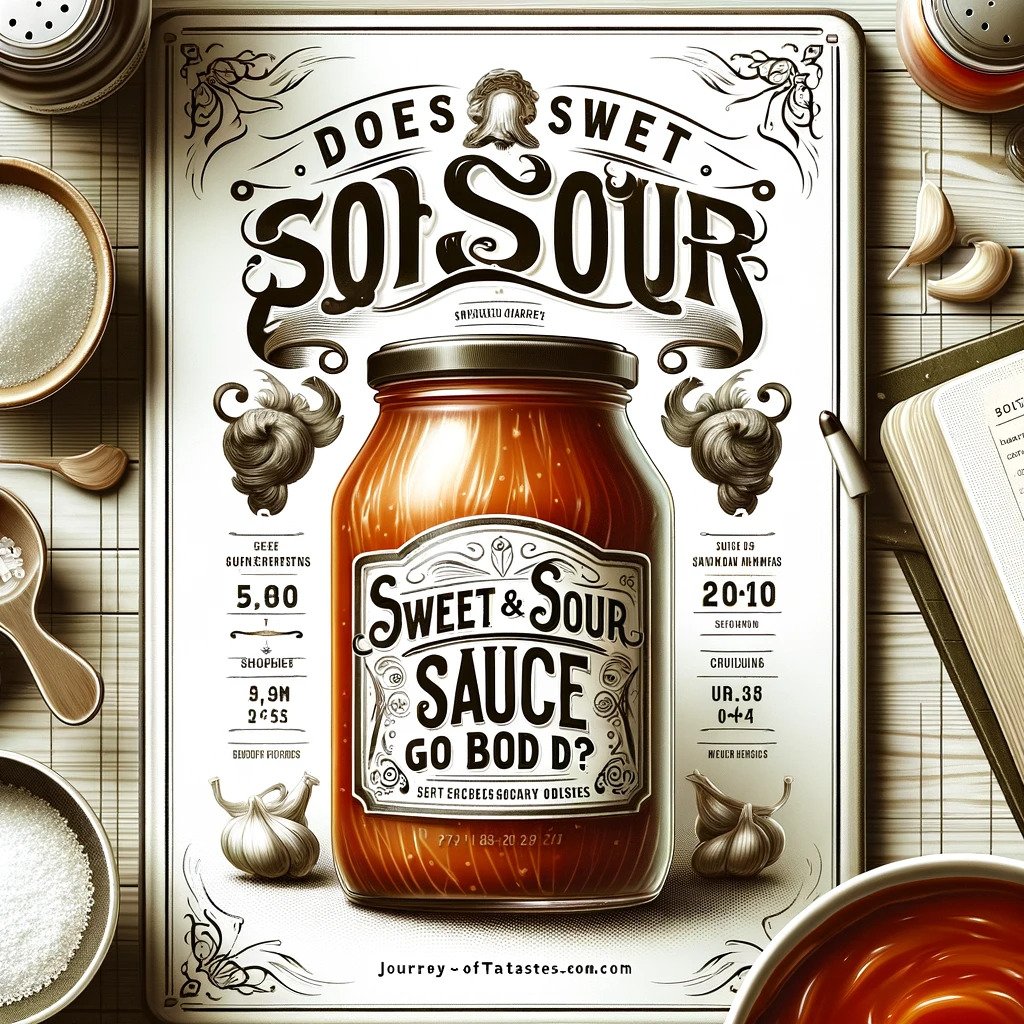In my culinary adventures, I’ve often marveled at how the sweet and sour sauce ingeniously combines the flavor of pineapple and orange juices with the subtle hints of tomato or banana ketchup. This fusion, thickened with cornstarch and balanced with water, not only suggests a harmonious blend of sweet and sour notes but also resonates with the rich culinary heritage of China, where it originated.
As someone who relishes exploring various cuisines, I’ve found this sauce to be a staple in many Chinese and Asian dishes, enhancing everything from roasted chicken to dumplings and chicken wontons.
However, a crucial aspect that often goes unnoticed is its shelf life. Like many, I learned carefully to handle this sauce to prevent it from going bad. Its longevity is something one must consider, especially since it is widely used.
Whether it’s a store-bought bottle or a homemade concoction, ensuring it’s stored well and carefully is essential. The tangy quality of the sauce can diminish, and the vibrant flavors can deteriorate if not handled with care. This is not just about preserving a sauce but about maintaining the integrity of the flavors that are so integral to the dishes it graces.
How to Tell If Sweet and Sour Sauce Is Bad?
When it comes to enjoying the unique blend of sweet and sour flavors in our favorite sauce, knowing when it has gone bad is crucial. The first sign to look for is a change in color. A dark coloration in your sauce, deviating from its usual light hue, often shows signs of spoilage. It’s not just about aesthetics; this change can indicate deeper issues.
Another critical aspect to be aware of is the odor. A good sweet and sour sauce should have a pleasant, inviting smell. However, if you notice an off odor coming from the bottle, it’s a strong indicator that the sauce has gone bad. This change in smell is a direct sign that the sauce is no longer fit for use.
Mold growth is a definite no-go. If you see white spots appearing on the surface of the sauce, it indicates fungal growth, which is extremely harmful. The presence of mold means the sauce has been compromised and should not be used in any type of dish.
Lastly, it’s essential to trust your senses. If something seems off, whether it’s the look, smell, or taste, it’s better to err on the side of caution. The difference between a good sauce and a spoiled one can often be apparent upon closer inspection. The key is to remain vigilant and detect these changes early to avoid consuming something potentially harmful.
How Long Does Sweet and Sour Sauce Last?
The longevity of sweet and sour sauce is a topic of interest for many culinary enthusiasts. Interestingly, its shelf life depends significantly on how it is made and stored. For instance, commercially made sauces typically remain good for 1-2 years past their best by date. This is due in part to preservatives added to extend their life span.
In contrast, homemade sweet and sour sauce has a relatively short life span. Without the preservatives found in readymade versions, it usually remains good for about half a year. The lack of artificial additives means it must be refrigerated to maintain its flavorful quality.
An interesting tip for prolonging the life of your sauce is to add vinegar. Vinegar not only enhances the taste but also acts as a natural preservative. This helps the sauce last longer. When using the sauce, it’s advisable to take it out of the fridge, use it as needed, and then put it back immediately. Keeping the temperature of the sauce uniform helps to prevent it from getting spoiled.
Understanding these differences is key. Whether it’s a commercially bought bottle or a jar of homemade delight, knowing how to properly store your sauce is essential. Keeping it refrigerated and monitoring any changes in color, smell, or texture will ensure you enjoy your sweet and sour sauce at its best, safely avoiding any potential spoilage.
How to Store Sweet and Sour Sauce?
Storing sweet and sour sauce correctly is essential to extend its lifespan and maintain its flavorful and delicious taste. The methods of storage can vary depending on whether it’s homemade or commercially bought.
Storing Commercially Bought Sauce
For canned sweet and sour sauce, the preservatives added during its production ensure it remains stable and good for use over an extended period. It’s best to store the can in a cool and dry place, like a kitchen spice rack. Ensuring the lid of its container is properly covered helps to prevent moisture from seeping in, allowing you to use it for a couple of months without spoilage.
Storing Homemade Sauce
Homemade sauce, on the other hand, is more vulnerable to spoilage due to the absence of preservatives. Adding ingredients like orange juice can make it more savory, but it’s crucial to refrigerate this type of sauce. Refrigeration not only prevents early spoilage but also helps in keeping the sauce flavorful for longer. Adding vinegar is another effective way to prevent mold and further increase its shelf life.
Refrigerating Sweet and Sour Sauce
Whether it’s leftover, homemade, or even an opened can of commercial sauce, refrigerating is key. It helps to keep the sauce stable and useful for much longer than when left at room temperature.
General Tips for Storing Sweet and Sour Sauce
- Use airtight containers to store both homemade and opened canned sauces.
- Keep the sauce refrigerated consistently to prevent changes in temperature that can lead to spoilage.
- Cover the sauce properly after each use to prevent exposure to air and contaminants.
- For dipping, marinating, or adding as an ingredient in cuisines, always use a clean spoon to keep the sauce sanitary.
By following these storage methods, you can enjoy your sweet and sour sauce in its best form for as long as possible.
What Happens If You Don’t Refrigerate Opened Sweet And Sour Sauce?
When an opened container of sweet and sour sauce is left unrefrigerated, several unwanted changes can occur, affecting its safety and quality.
Bacterial and Yeast Growth
Unrefrigerated sweet and sour sauce becomes an ideal environment for bacterial and yeast growth. Ingredients like pineapple, soy sauce, and onions add nutrients and moisture, which allow these microbes to multiply quickly at room temperature. Refrigeration typically slows down this process, but without it, the risk of foodborne illness increases rapidly.
Fermentation
Fermentation is another result of leaving sweet and sour sauce at room temperature. The sugars in the sauce undergo uncontrolled fermentation, with yeasts metabolizing the sugars into alcohol and carbon dioxide. This reaction leads to bubbling, frothing, and an alcohol smell, significantly altering the sauce’s flavor profile.
Mold Growth
Mold growth is a common issue with unrefrigerated sauces. If you notice fuzzy mold on the surface, it’s a clear sign of spoilage. Mold prefers foods that are high in moisture and low in acidity, and it spreads quickly. Refrigeration helps prevent this by slowing down the microbes.
Off Flavors, Smells, and Textures
Bacterial spoilage can also lead to off flavors, smells, and textures in the sauce. It may smell rotten or “off”, taste sour or bitter, and have a slimy, rope-like texture. These are definite signs that the sauce is spoiled and unsafe to eat.
Food Poisoning
One of the most serious consequences of consuming spoiled sweet and sour sauce is food poisoning. High levels of microbes in the sauce can cause symptoms like vomiting, diarrhea, and abdominal cramps, often occurring hours or days after ingesting the contaminated sauce. This is particularly life-threatening for high-risk groups.
Understanding these risks highlights the importance of proper storage of sweet and sour sauce. Always refrigerate it after opening to maintain its quality and safety.
How Long Can Sweet And Sour Sauce Sit Out Unrefrigerated?
Understanding how long sweet and sour sauce can remain safe outside the refrigerator is crucial. The USDA recommends discarding the sauce if it has been left out for more than 4 hours at room temperature. This guideline becomes even more stringent in warmer conditions, specifically in temperatures above 90°F, where the sauce should be discarded after just 2 hours. The rationale behind this is the rate at which bacteria multiply in warmer environments, increasing the risk of foodborne illnesses.
Even if the sauce looks, tastes, and smells normal, it may still harbor harmful microbes. These invisible threats can pose significant risks to food safety. Therefore, it’s always better to Don’t take risks when it comes to perishable items like sweet and sour sauce. The presence of bacteria can escalate quickly, especially in improper storage conditions, making it essential to adhere to these safety guidelines.
Conclusion
Sweet and sour sauce, much like any other food product, is subject to spoilage, particularly when not stored properly. The key takeaways for maintaining its quality and safety include adhering to storage guidelines, such as refrigeration and awareness of how long the sauce can be left at room temperature. By understanding the signs of spoilage such as changes in color, odor, and texture, and recognizing the risks associated with bacterial and mold growth, consumers can ensure they enjoy this delicious condiment without compromising their health.
Remember, when in doubt, it’s always safer to discard the sauce than risk foodborne illnesses. This approach not only preserves the integrity of your meals but also upholds the highest standards of food safety in your kitchen.
Frequently Asked Questions
1.Can You Freeze Sweet And Sour Sauce?
Yes, you can freeze sweet and sour sauce. Freezing extends its shelf life without significantly altering its taste or texture. It’s best to store it in an airtight container or freezer-safe bag.
2. Can You Save Sweet And Sour Sauce Left Out Overnight?
It’s not recommended to use sweet and sour sauce left out overnight at room temperature. Doing so increases the risk of bacterial growth, making it unsafe for consumption.
3. Is Bottled Sweet And Sour Sauce Dangerous Past Its Expiry?
While bottled sweet and sour sauce past its expiry date may not be immediately dangerous, its quality and safety can be compromised. It’s advisable to check for signs of spoilage like off smell, color change, or mold before use.
4. Can I Eat Expired Sweet And Sour Sauce?
Consuming expired sweet and sour sauce is risky. If the sauce shows no signs of spoilage and has been stored properly, it might be safe to eat. However, it’s generally better to err on the side of caution and avoid consumption.
5. How Long Is Sweet And Sour Sauce Good In Fridge?
Sweet and sour sauce can typically last up to 6 months in the fridge if stored properly in an airtight container. The refrigeration slows down the growth of bacteria and preserves the sauce’s quality for a longer period.

